Latin name: Brunfelsia
Category: annual and perennial herbaceous plants
Origin: Tropics of Central and South America
Brunfelsia - fragrant beauty of the tropics
The nightshade family is famous not only for representatives of vegetable crops, such as capsicum, nightshade, but also for the most beautiful decorative flowering plants.
Brunfelsia - a genus formed from thirty varieties of bright flowering plants, settled in the Solanaceae family. This beauty is represented by evergreen flowering shrubs or bushy trees. But not only does brunfelsia attract with its beauty, it also has a delicate, refined aroma that can compete with expensive perfumes.
The birthplace of this fragrant exotic miracle is considered to be the southern and central part of the American continent, as well as the Lesser and Greater Antilles.
Natural environmental conditions allow a slow-growing plant to gain five or eight meters in height. This wonderful plant has beautiful leathery with a matte sheen, oval or lanceolate, alternate, dark green, fleshy leaf plates. With short petioles, the leaves are alternately attached to the branches or grouped closer to the top.
Large eight-centimeter flowers have a tubular corolla and a flat limb organized by five petals. Flowers of a single type or collected by companies in inflorescences, like all nightshade inflorescences, from five to twelve pieces have a delicate purple-white, yellowish or purple color.
Sometimes you can find bushes in which the inflorescences change color, giving the plant even more uniqueness. Brunfelsia inflorescences are represented by a brush or panicle, like the main type of nightshade inflorescences.
Brunfelsia pampers with flowering even in winter. The end of flowering is marked by the appearance of fruits in boxes, the configuration of which is not similar to each other. Fruits of nightshade ripening become green, brown, yellow or orange. The interior is filled with long, flattened red-brown seeds.
This valuable crop is very interesting and suitable for growing indoors. It makes excellent amateur collections. At home, the brunfelsia flower looks like a compact bush, reaching a height of fifty centimeters.
This interesting and unusual name was given to the flower by the famous scientist, botanist Carl Linnaeus out of respect for his fellow monk and scientist Otto Brunfels, who was closely involved in studying and describing the appearance and all the qualities of this plant.
Another flower is called "Yesterday-Today-Tomorrow" or "morning-day-night". The strangeness of the popular name lies in the existence of multi-colored buds on the plant, which changed throughout the day and throughout the life of the flower.
There are other popular names for this representative of the nightshade - brunfelsia, franciscea, manaka.
The name of the manak is taken from the legend. In ancient times, a girl named Manaka loved and revered the brunfelsia flower very much and even helped people return unrequited love with a remedy made from a flower. And she did it. After all, the extract of this nightshade plant has a psychotropic effect. This flower is presented by sorcerers and shamans as a "sacred herb", which has a pleasant smell after sunset.
Even in ancient times, in the homeland of brunfelsia, the indigenous Amazonian peoples performed shamanic rituals with it. The medicinal properties of the plant were already widely known. The roots and bark were used to make tea, which was given to a sick person to drink. Thanks to this drug, shamans saw what a person was sick with.
Brunfelsia helped the Amazons to cure fever, syphilis, arthritis, snake bites. Despite this, official medicine does not give the green light to the development of drugs from brunfelsia, although science has shown the presence of scopoletin in the plant.
It helps to normalize blood pressure, has anti-inflammatory, antibacterial and analgesic effects, can cure asthma and bronchial diseases, keeps serotonin at the proper level, reduces depressive states, participates in cleansing the liver, lowers high temperatures.
Having considered the useful qualities of this representative of the nightshade, it should be noted that the plant is very toxic.
The independent use of brunfelsia inside is not recommended. This procedure is fraught with severe poisoning and even death.
Brunfelsia species
Australian Brunfelsia (Brunfelsia australis)
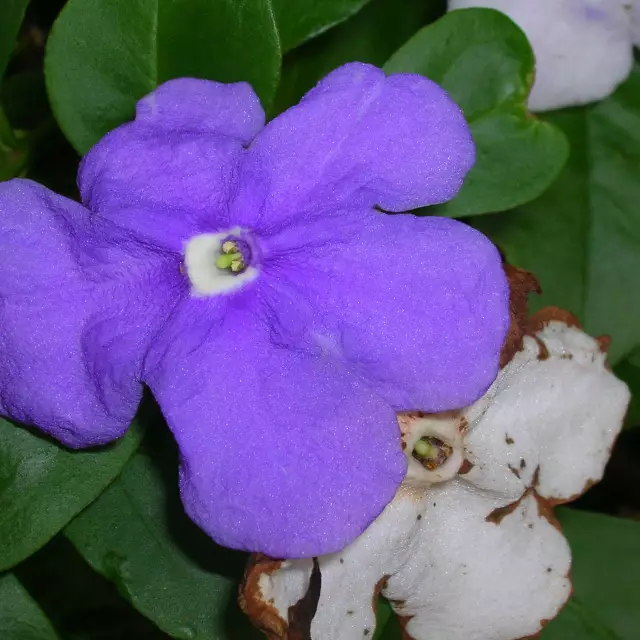 This species is represented by compact graceful bushes up to sixty centimeters high. During early flowering, these valuable ornamental shrubs are covered with large six-centimeter showy white or purple flowers, the strong and sweet aroma of which is pleasant to others. The flowers are formed by five purple petals and are the perfect complement to the green pointed leaves.
This species is represented by compact graceful bushes up to sixty centimeters high. During early flowering, these valuable ornamental shrubs are covered with large six-centimeter showy white or purple flowers, the strong and sweet aroma of which is pleasant to others. The flowers are formed by five purple petals and are the perfect complement to the green pointed leaves.
This representative of the nightshade is a lover of open areas, perfectly plants gardens, parks, home greenhouses.
In their native areas, residents have found use for some parts of the plant. The fruit of nightshade in dried form is ground and an excellent seasoning is obtained, as an additive to food, and is also used for medicinal purposes.
Brunfelsia American (Brunfelsia americana)
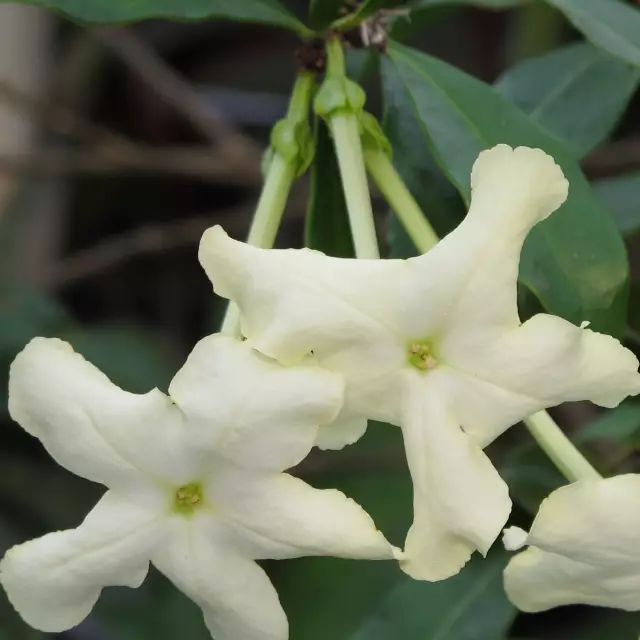 A very original nocturnal beauty brunfelsia americana with a unique intense aroma in the evening and at night, looks great both at home and in garden plantings. This miracle can reach six meters in height. The plant has light green elliptical leaflets. Cream-colored flowers have a ten-centimeter corolla and a long tube.
A very original nocturnal beauty brunfelsia americana with a unique intense aroma in the evening and at night, looks great both at home and in garden plantings. This miracle can reach six meters in height. The plant has light green elliptical leaflets. Cream-colored flowers have a ten-centimeter corolla and a long tube.
Brunfelsia Lactea
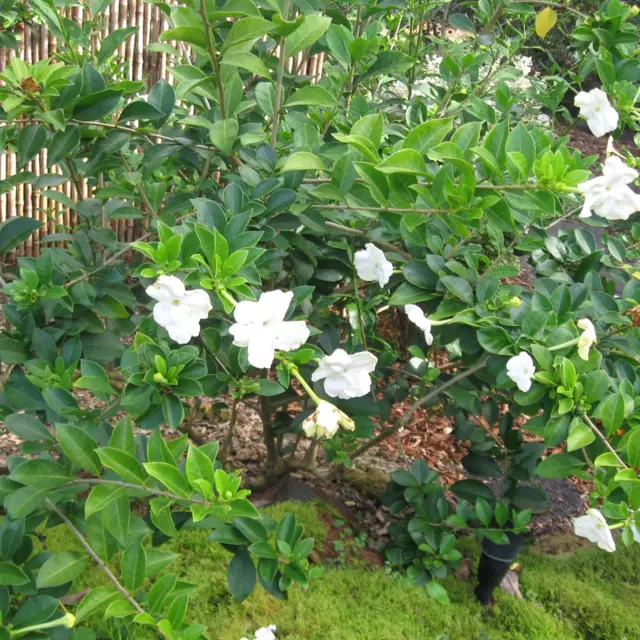 This Brazilian miracle has its popular name "Lady of the Night" for the unique, fragrant, delicious aromas emitted by the plant at night. In its natural environment, a shrub or tree reaches a height of seven meters. Dark green oval or obovate leaves have a leathery structure up to fifteen centimeters long. This cultivar has creamy white flowers.
This Brazilian miracle has its popular name "Lady of the Night" for the unique, fragrant, delicious aromas emitted by the plant at night. In its natural environment, a shrub or tree reaches a height of seven meters. Dark green oval or obovate leaves have a leathery structure up to fifteen centimeters long. This cultivar has creamy white flowers.
The ripe fruit of the nightshade - a fleshy berry has a purple or light brown color. This amazing Amazonian brunvelsia prefers warm southern window sills and needs regular watering with occasional mistings in hot rooms.
Avoid direct sunlight, and in winter - cold.
Brunfelsia Nitida
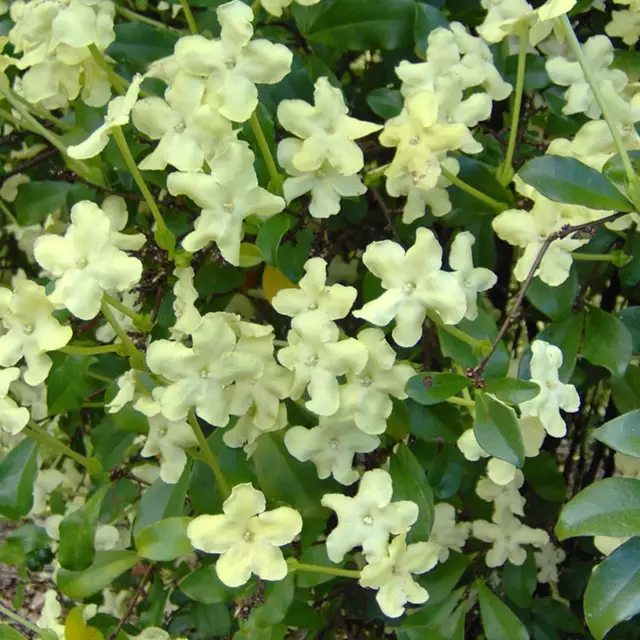 A very original exclusive variety with a unique arrangement of flowers. These handsome men not only attract attention with their beauty, but also with a gentle pleasant smell.
A very original exclusive variety with a unique arrangement of flowers. These handsome men not only attract attention with their beauty, but also with a gentle pleasant smell.
Brunfelsia Grandiflora
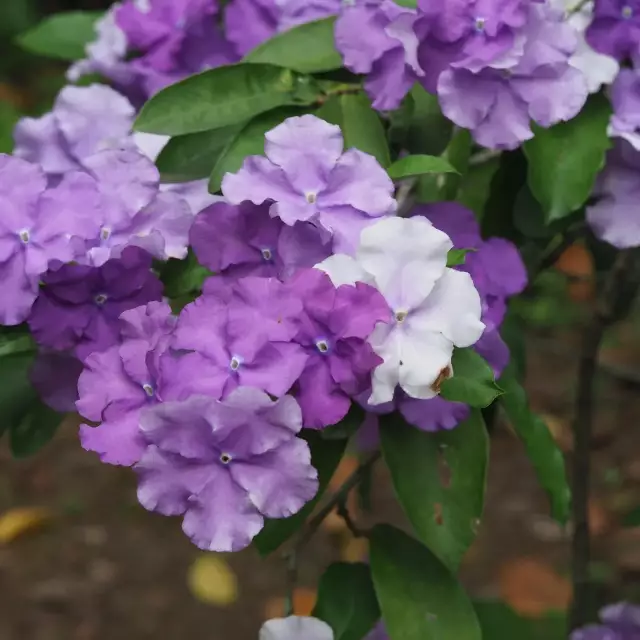 One of the common varieties of manaka. It likes to grow in bright light, but the direct rays of the scorching sun must be avoided so that the plant does not lose its decorative effect. Brunfelsia grandiflora flaunts dark green elongated lanceolate leaves. No less attractive are large eight-centimeter flowers of a blue-lilac hue. In the process of flowering, they acquire a light blue color.
One of the common varieties of manaka. It likes to grow in bright light, but the direct rays of the scorching sun must be avoided so that the plant does not lose its decorative effect. Brunfelsia grandiflora flaunts dark green elongated lanceolate leaves. No less attractive are large eight-centimeter flowers of a blue-lilac hue. In the process of flowering, they acquire a light blue color.
Brunfelsia latifolia variegata
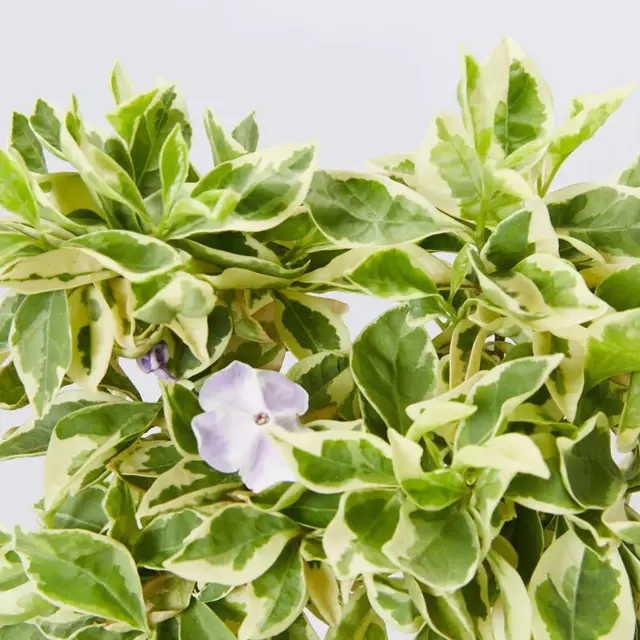 This variety pleases the eye with a very interesting and unusual shape and color of the leaves. A compact bush does not exceed a meter height barrier. Blooming it can be contemplated throughout the summer period. White and purple flowers have a pleasant aroma.
This variety pleases the eye with a very interesting and unusual shape and color of the leaves. A compact bush does not exceed a meter height barrier. Blooming it can be contemplated throughout the summer period. White and purple flowers have a pleasant aroma.
Brunfelsia home care
Brunvelsia, like all nightshade crops, is very unpretentious, hardy and very undemanding to growing conditions. But in order for this tropical exotic beauty to feel comfortable, it is desirable for her to create conditions close to natural.
Choice of location and temperature
Brunfelsia will be grateful for the year-round supply of bright diffused lighting. Such illumination will enable the exotic guest to acquire fleshy leaves and bright fragrant flowers. For this, the eastern, southeastern and southern dislocations are most suitable. The bright rays of the sun must be shaded.
In the warm season, the brunfelsia flower will not refuse to move to the territory of a balcony, terrace or garden.
Temperature indicators are desirable without sudden changes. Summer take-off - 20-22°C, and in late autumn, during the period of rest and budding, the plant will be pleased to be at a temperature of 10-15°C.
Humidity and watering
A tropical houseplant wants high humidity in the air to maintain its decorative effect. Regular spraying, with the exception of the flowering period, will be pleasant and useful for the nightshade indoor representative. A blooming manaka can be content with a tray of wet gravel or a container of water. Flower pots with automatic watering will also solve the problem of indoor humidity.
Regular airing of the room will be pleasant for an easy-to-care houseplant.
Watering an unpretentious indoor flower for the lazy, a very big lover of soft water, must be done regularly, keeping the soil moist, but without stagnant water in the flowerpot. If the soil is too dry, buds and flowers will fall off, and excessive moisture in the soil and low temperature will lead to rotting of the rhizome.
Soil and its top dressing
A ready-made, fertile, well-drained soil mixture that has a neutral reaction can be bought at a Saintpaulia store. A good quality substrate for inpidual preparation should contain garden soil, humus, coarse sand and perlite (2:2:1:1). If there is peat, add it to the mixture.
To stimulate room brunfelsia during the warm period, once every fourteen days, top dressing with liquid complex mineral fertilizers is recommended. In winter, it is desirable to apply fertilizers with nitrogen.
Transfer
It is desirable to transplant a tropical beauty after the end of the flowering period. An annual transplant of young bushes is desirable, and an adult plant is disturbed at intervals of two or three years. Annual renewal of the top layer of the substrate will be beneficial for the houseplant. For brunfelsia, which has fibrous roots, flowerpots with a wide bottom and drainage holes are suitable.
A quality drainage layer is required.
Manaka trimming
To form a beautiful lush bush, it is advisable to regularly pinch and cut it after the flowering period. The branches are shortened by a third of their length. The cut parts of the plant are suitable for obtaining a new plant.
Brunfelsia reproduction
To acquire a brand new offspring of a tropical exotic, shoots, semi-lignified cuttings or seeds are used.
Cuttings are planted in a peat-perlite mixture in the summer. The temperature regime is kept within 25 ° C. It is imperative to pinch young specimens.
In winter, manaka seeds can be sown in a sandy-peat substrate, mini-greenhouse conditions can be created and temperatures not lower than 25 ° C. Shoots will appear in thirty days, they need to be transplanted into separate pots.
Diseases and pests of brunfelsia
In case of violation of the comfortable growing process, indoor tropical beauty can be honored with a visit by spider mites and scale insects. When these uninvited friends are found, the plant is treated with a solution of soap and washed under running water. If the influx of parasites continues, apply insecticides.
Difficulties encountered in growing
- Brunfelsia leaf plates fall off - excessive watering or, conversely, the soil is too dry.
- The leaves have turned pale - the lighting is too bright.
- The yellow color of the leaves - when watering, too hard water stagnates in the flowerpot, in the soil there is an underestimated level of iron.
Brunfelsia is very poisonous. When communicating with her, it is necessary to use protective equipment, not to neglect safety measures.
Poisonous plants also include anthurium, euonymus, zephyranthes, monstera, jatropha.
When all the growing requirements put forward by a tropical beauty are met, we get a very colorful flowering bush that will wonderfully transform any interior.
Other indoor plants alphabetically can be viewed on the site when you open the catalog of indoor plants from a to z.















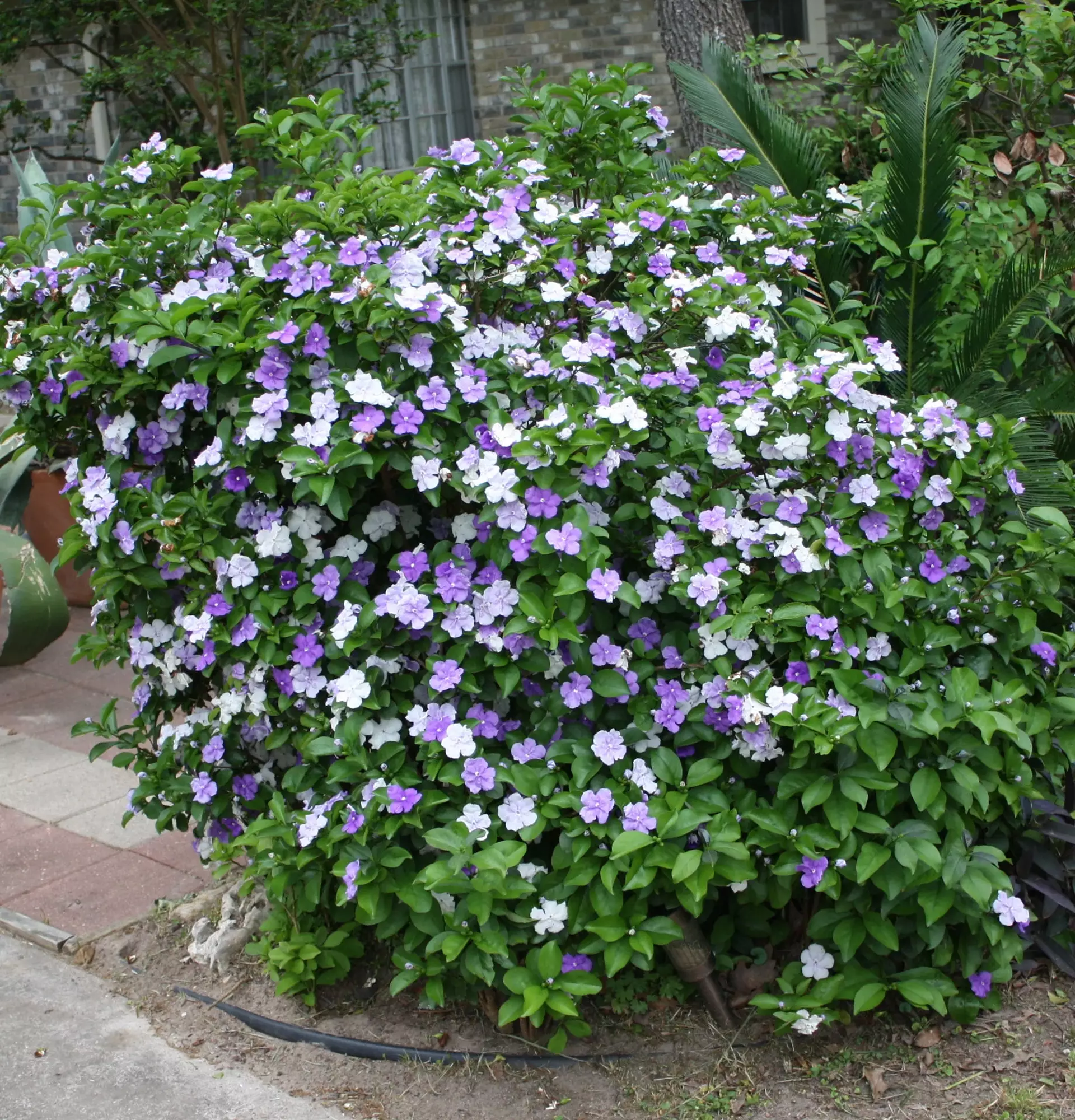
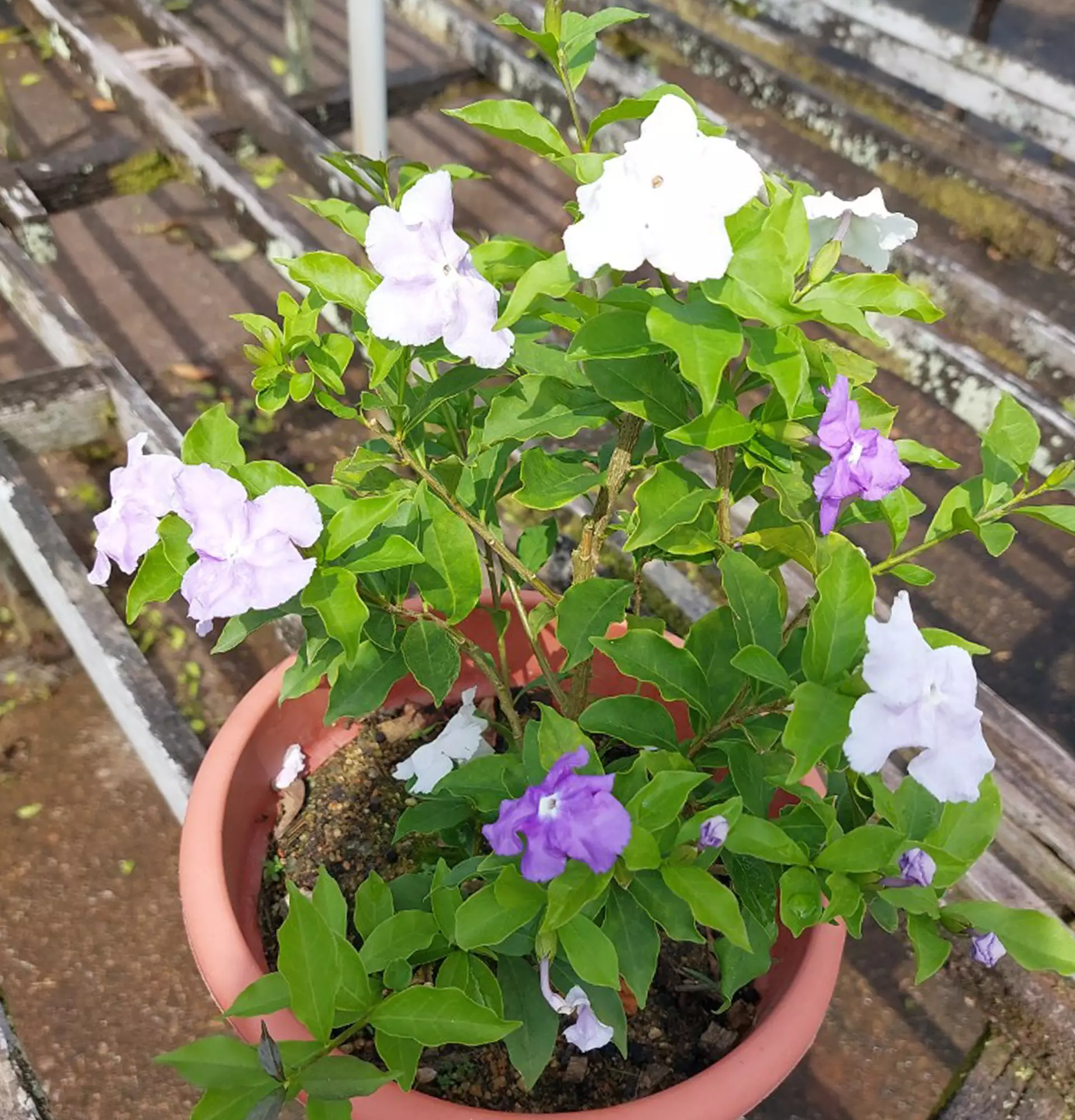
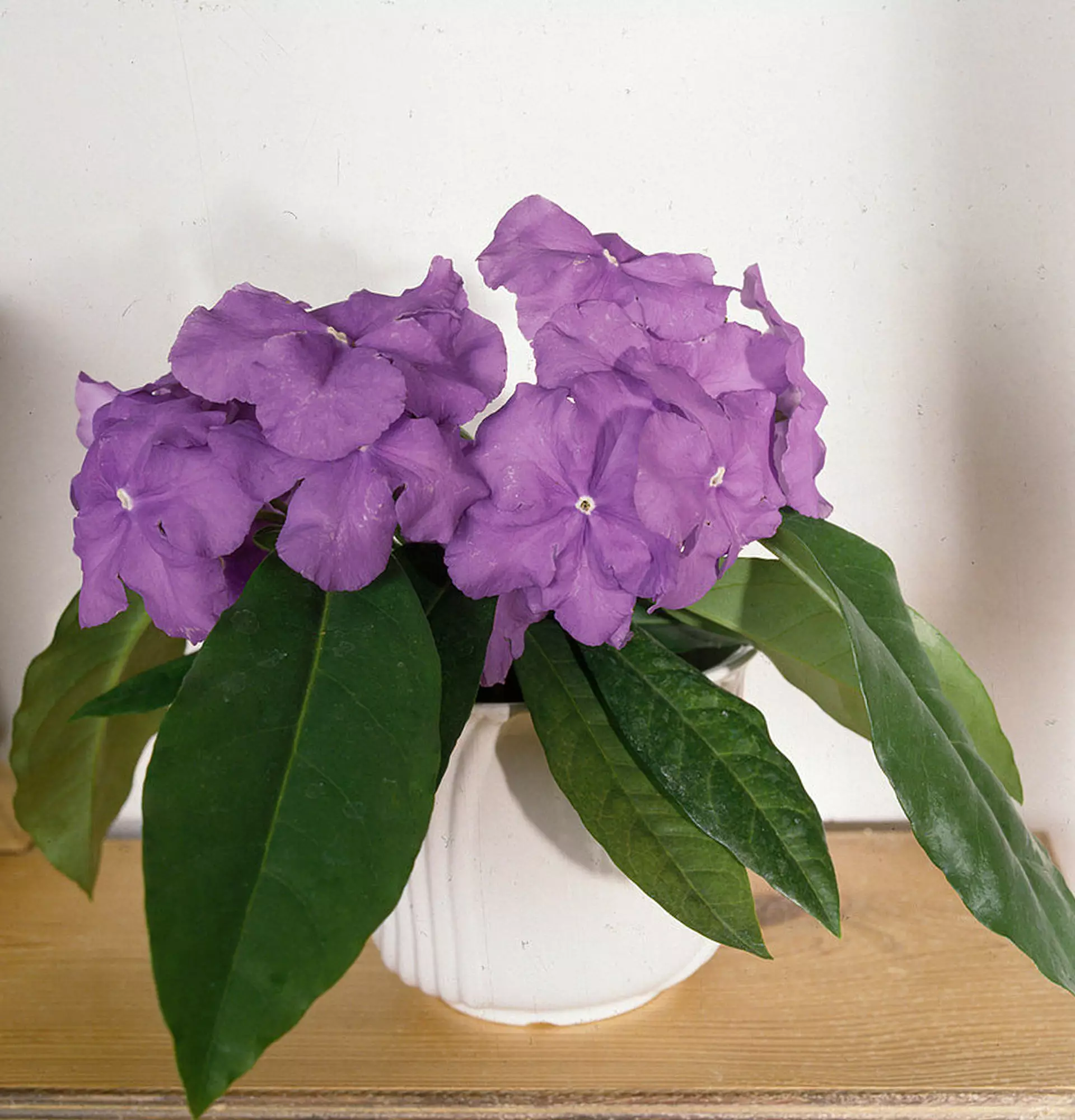

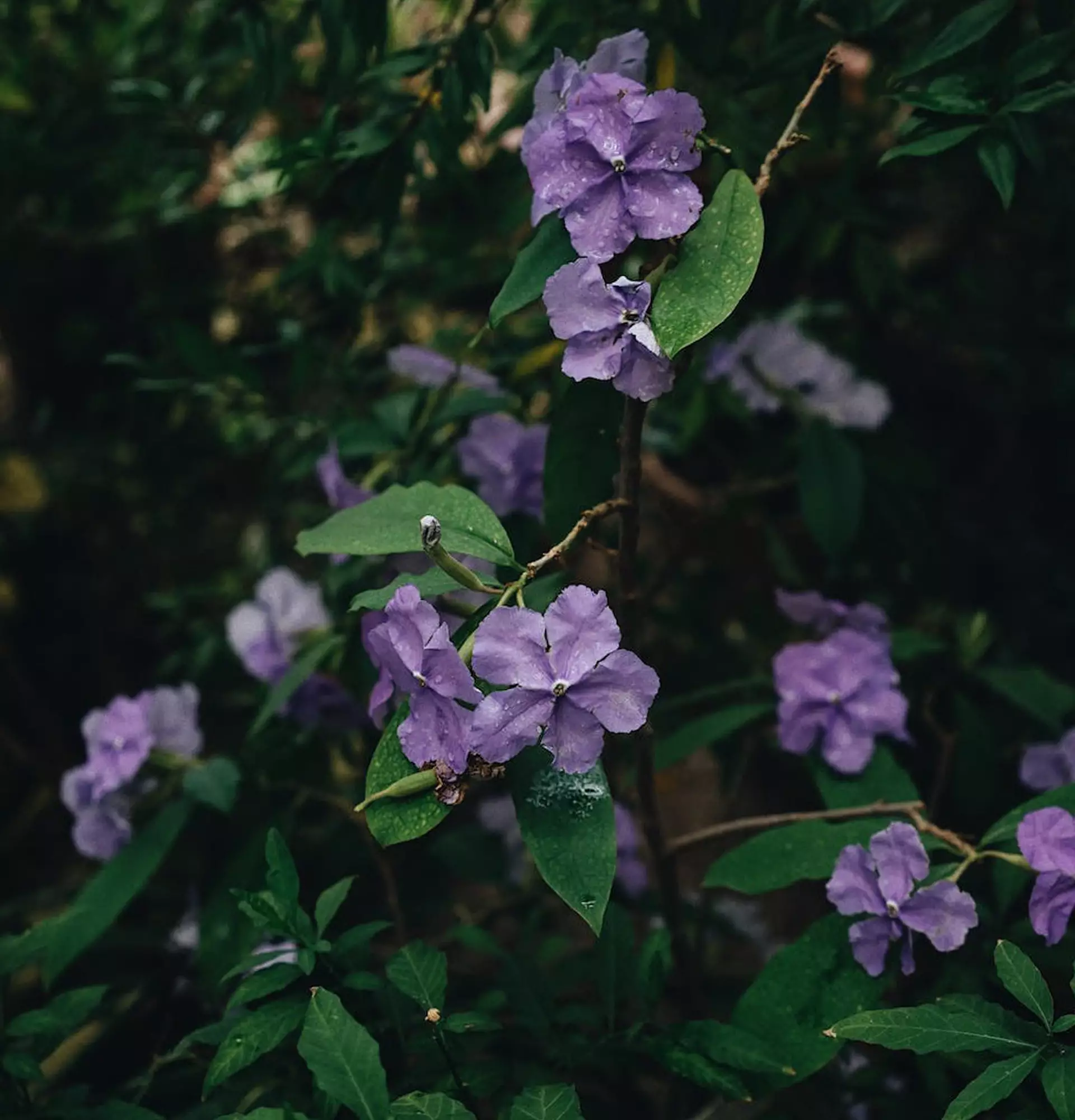
Write comments
Comments